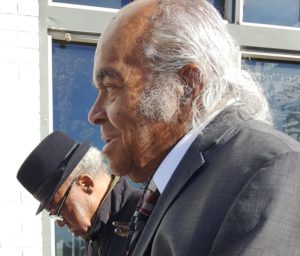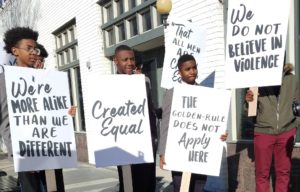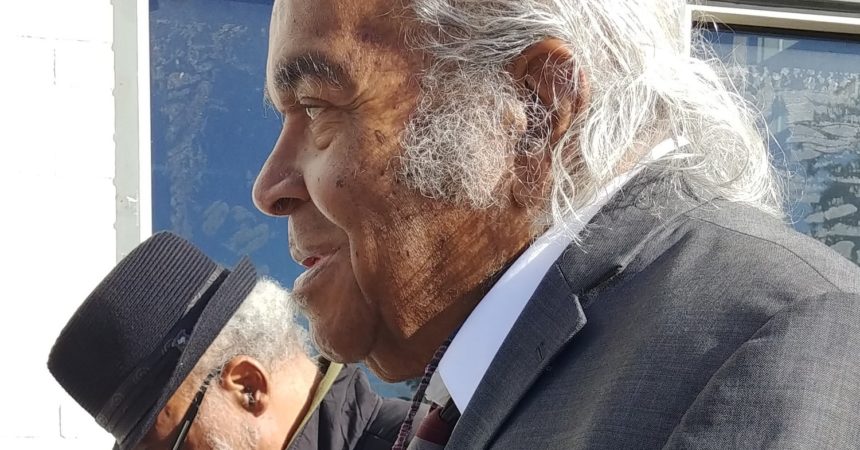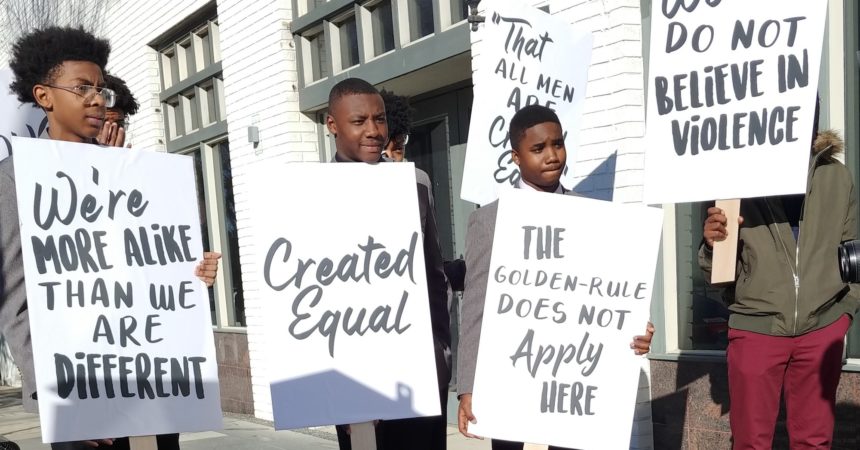Activists recall students’ lunch counter sit-in
By St. Clair Murraine
Outlook staff writer
Sixty years later, Rev. Henry Steele still believes that when he and other young people followed the lead of two sisters and staged a sit-in at the Woolworth’s lunch counter it was the right thing to do.
In fact, Steele, the son of Tallahassee’s civil rights icon CK Steele, said the sit-in was pivotal to bringing about racial changes in Tallahassee. He was 16 years old when he joined the protest and spent eight nights in jail.

Civil right attorney John Due (foreground) and Rev. Henry Steele recalled their roles in a student sit-in 60 years ago.
Photo by St. Clair Murraine
“I felt good doing something I believe I was right in doing,” Steele said. “Even now it gratifies me.”
Steele was among the speakers at a press conference where plans were announced for commemorating the sit-in on Feb. 13. The announcement was made on the intersection of North Monroe and Jefferson streets at the Civil Rights Heritage Walk, just a few yards from where the sit-in took place.
“This history appealed to us because it’s ours,” said Liz Joyner, CEO of Village Square. “My goal is that every school kid in this community can recite this history. History like this you have to tell it and retell it for people to embrace it. That’s part of what we are doing.”
The anniversary event takes place at The Moon, beginning at 6 p.m. Leon County government is teaming up with the Village Square for the event, which they’ve titled “created equal.”
“The only difference is the experiences we’ve had and the people we’ve met, the schools we attended and families we were raised in,” said Bryan Desloge, chairman of Leon County Commission. “The point of this is to bring people together and have the discussion so that we don’t run into some of the other issues we’ve seen around the country.”
Equality was what the students from FAMU and FSU wanted when they decided that they had the same rights as Whites to be served at the Woolworth’s lunch counter. Other students in the South had taken the same tact to demonstrate against segregation.
Patricia Stephens and her sister, Priscilla, led the protest. They also were central to the growth of the Congress of Racial Equality.
Steele recalled how he and others had to persevere to make it through the protest. They started the protest on Feb. 13, then returned a week later. Police began to arrest them then.
“There were times, we’d become a little distressed by all yelling, name-calling, bigotry,” he said. “I never felt scared to do what I was doing (but) there were moments when it seemed incredibly frightening.”
Civil rights attorney John Due, Priscilla’s husband, said his wife was fighting for equal rights until the day she died.
“Her attitude has always been this; I didn’t ask to be born, but since I’m here I’m going to make it better for myself and everybody else,” Due said.

Teenagers from the Omega Lamplighters organization show replicas of signed that protesting students carried during a sit-in downtown.
Photo by St. Clair Murraine
“They recognized it was not just an issue of civil rights but human rights,” he said of the protesters. “They were treated like dogs. This is why it’s important for the next generation to understand that the struggle continues.”
A group of young men from the Omega Lamplighters organization created the backdrop at the press conference. They carried signs that Joyner said are replicas of the original placards carried by the students 60 years ago.
One sign read: “We are more alike than we are different.” Another simply said “created equal.” Then there was one that read “we do not believe in violence.”
That went to the core of the students’ strategy. They all did time in jail instead of posting bail, a choice Due said they made because paying would imply they were guilty of a crime.
The protesters set an example that his generation has to follow, said Terrance McPherson, one of the teenagers with Omega Lamplighters.
“We have to use the encouragement and do things that we need to in the community,” McPherson said. “That’s bringing peace to the community so we can all come together to press toward more movement like this so the community could be in peace and not all the gang violence, gun violence and everything else that is going on.”









